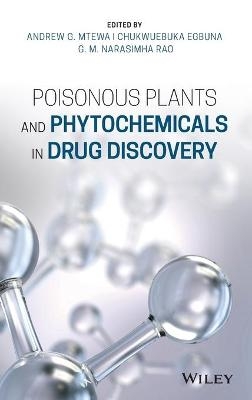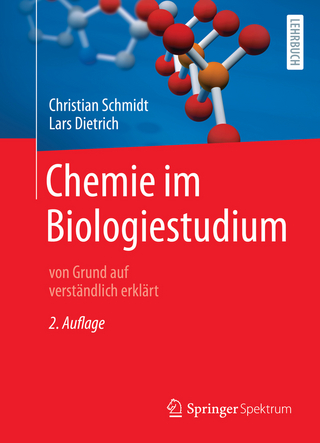
Poisonous Plants and Phytochemicals in Drug Discovery
Wiley-Blackwell (Verlag)
978-1-119-65023-2 (ISBN)
- Provides a comprehensive resource on phytotoxins, covering historical perspectives, modern applications, and their potential in drug discovery
- Covers the mechanisms, benefits, risks and management protocols of phytotoxins in a scientific laboratory and the usefulness in drug discovery
- Written and edited by leading researchers in phytochemistry, medicinal chemistry, analytical chemistry, toxicology, and more
- Presents chapters in a carefully designed, clear order, making it an ideal resource for the academic researcher or the industry professional at any stage in their career
Plant-based toxins have historically always remained significant in community use as lethal substances in hunting and deterrents to wild animals or human beings. However, some toxins are also known to have medicinal properties or contain derivatives that promise significant breakthroughs in drug discovery. These toxins are, at present, known in their crude plant forms with some known at a molecular level. Despite this being the case, there are limited sources where researchers, students, policy makers, and drug discoverers can find detailed information about these plants.
ANDREW G. MTEWA trained in Medicinal Chemistry for his PhD under the WCAIR at the University of Dundee in Scotland and also at the Mbarara University of Science and Technology in Uganda. He teaches Chemistry at the Malawi University of Science and Technology in Malawi.
CHUKWUEBUKA EGBUNA, MICCON, AMRSC, is a chartered chemist, a chemical analyst, and an academic researcher. He obtained his BSc and MSc degrees in Biochemistry at Chukwuemeka Odumegwu Ojukwu University, Anambra State, Nigeria. He is a PhD fellow in Nutritional Biochemistry/Toxicology with the World Bank Africa Centre of Excellence for Public Health and Toxicological Research (ACE-PUTOR), University of Port-Harcourt, Rivers State, Nigeria.
DR. G. M. NARASIMHA RAO is an Associate Professor of Botany at Andhra University, where he also obtained his MSc in Botany and M.Phil in Marine Algal Ecology.
Chapter 1: HISTORICAL USE OF TOXIC PLANTS
1.1 Introduction to toxic plants
1.2 Plant sources of poisons and their active principle
1.3 Poisonous plants as sources of traditional and modern medicines
1.4 Toxic plants and justice
1.4.1 Toxic plants in capital punishment
1.4.2 Trial by ordeal
1.5 Toxic plants in poisoned weapons
1.5.1 Arrow poisons
1.6 Plant fishing poisons/ piscicides/ ichthyotoxins
1.7 Poisonous plants as food
1.8 Poisonous plants as biopesticides
1.9 Toxic psychoactive plants for recreational and religious purposes
1.10 Poisonous plants in warfare & bioterrorism
1.11 Poisonous plants as carcinogens and teratogens
1.12 Conclusion
Chapter 2: CLASSIFICATION OF PHYTOTOXINS AND THEIR MECHANISMS OF ACTION
2.1 Introduction 2
2.1.1 Endophytic phytotoxins 3
2.1.2 Secondary metabolites 4
2.2 Possible categorization 4
2.2.1 Biological characteristics 4
2.2.2 Chemical characteristics 5
2.3 Currently available classification tools 7
2.4 Role of phytotoxin classification 7
2.4.1 Drug discovery 8
2.4.2 Environmental monitoring 8
2.4.3 Phytotoxins, aquatic life and Water quality 8
2.4.4 Air contamination 9
2.4.5 Food contamination 9
2.4.6 Security and safety services 10
2.4.7 Agricultural 10
2.5 Brief mechanisms of action 10
2.6 Conclusion 10
Reference 11
CHAPTER 3: POISONOUS PLANTS AS SOURCES OF ANTI-CANCER AND OTHER DRUGS
3.1 Introduction 2
3.2 Poisonous plants in cancer treatment and others disease 3
3.3 Poisonous Plant based anti-cancer drugs on the market 35
3.4 Poisonous Plant based drugs on the market against other diseases 36
3.5 Conclusion 38
References 38
Chapter 4: DRUGS IN CLINICAL PRACTICE FROM TOXIC PLANTS AND PHYTOCHEMICALS
4.1 Introduction 2
4.2 Drugs in clinical practice from toxic plants 3
4.3 Drugs Acting on the Central Nervous System 4
4.4 Physostigmine and Other Acetylcholinesterase Inhibitors 8
4.5 Antitumor Agents 9
4.6 Other Drugs 12
4.7 Nicotine and the neonicotinoids 14
References 15
Chapter 5: TOXICOLOGY AND HEALTH BENEFITS OF PLANT ALKALOIDS
5.1 Introduction 1
5.2 Pharmacological Properties of alkaloids 4
5.3 Toxicological Properties of Alkaloids 8
5.5 Acute and Chronic Toxicities 9
5.5.1 Genotoxicity and Tumourigenicity 10
5.5.2 Lung, neurotoxicity and teratogenicity 11
5.6 Factors that Influence the Toxicological Profile of Alkaloids 13
5.7 Conclusion 14
References 14
Chapter 6: CHEMICAL AND PHARMACOLOGICAL MECHANISMS OF PLANT-DERIVED NEUROTOXINS
6.1 Introduction 2
6.2 Nerve Agents 3
6.3 Chemical Mechanisms of Neurotoxicity Induced by Organophosphate Nerve Agents 4
6.4 Mustards 5
6.5 Effect Of 2, 2’-Dichlorethyl Sulphide On Skin 6
6.6 Effect of HD on Other Organs 7
6.7 The activation of HD 7
6.8 Mechanism of Action 8
6.8 Plant natural neurotoxins 10
6.9 Plant Glycosides 13
6.10 Conclusion 13
Reference 14
Chapter 7: PHYTOSEDATIVES FOR DRUG DISCOVERY
7.1 Introduction 2
7.2 Treatment of neuro-psychological disorders: the current scenario 3
7.3 Phytosedatives: desirable alternatives to synthesized drugs 3
7.4 Different classes of phyto-sedatives 4
7.4.1 Flavonoids 5
7.4.2 Alkaloids 7
7.5 Essential oils 8
7.6 Other classes of phytosedatives 9
7.7 Plants with reported sedative actions 14
7.8 Conclusion 24
References 24
Chapter 8: MUSHROOM: SPECIES, CLASSIFICATION: BIOACTIVES IN POISONOUS AND EDIBLE MUSHROOMS
8.1 Introduction 2
8.2 Classification of mushrooms 2
8.2.1 Edible Mushroom 3
8.2.2 Non-edible Mushroom 4
8.3 Bioactive agents in Mushroom species 4
8.4 Conclusion 16
Chapter 9: TOXICITY PROTOCOLS FOR NATURAL PRODUCTS IN THE DRUG DEVELOPMENT PROCESS
9.1 Introduction 2
9.2 In Vitro toxicity testing for Natural products 3
9.2.1 Cell Culture Method for Toxicity Testing 3
9.3 Methods used for In vitro toxicity study 4
9.3.1 MTT Assay 4
9.3.2 Neutral red uptake assay 4
9.3.3 Lactate Dehydrogenase Assay 4
9.4 In Vitro Models for Liver Toxicity 4
9.5 In vitro models Nephrotoxicity study 4
9.6 In vitro model for dermal toxicity testing 4
9.7 Mutagenicity Testing In Vitro 4
9.8 Bacteria cell system 4
9.8.1 Reproductive and Teratogenicity Studies in –Vitro 4
9.9 In Vivo toxicity testing of natural product. 4
9.9.1 Acute Toxicology 4
9.2.2 Sub-chronic Toxicity Test 4
9.9.3 Chronic Toxicity Test 4
9.9.4 Dermal and Ocular Toxicity 4
9.9.5 Toxicity Testing for Fertility and Reproduction 4
9.9.5 Combined Repeated Dose Toxicity Study with the Reproduction/Developmental 4
9. 10 Conclusion 4
Chapter 10: QUALITY CONTROL FOR THE SAFETY OF NATURAL PRODUCTS
10.1 Introduction 2
10.2 Quality Assurance of herbal products 3
10.3 Methods of Quality Control for herbal products 5
10.4 WHO Guidelines for Quality Standardization of Herbal formulations 8
10.4.1 Quality Control of Crude Material 8
10.4.2 Identity of Plant Material 9
10.4.3 Safety Assessment and Documentation 9
10.5 Concept of Validation in Herbal Products 10
10.6 Challenges Related to The Quality Control and Monitoring the Safety of Herbal Products 11
References 12
Chapter 11: SECONDARY METABOLITES AND TOXINS OF MICROBIAL ORIGIN FOR THE TREATMENT OF DISEASES
11.1 Introduction 2
11.2 Antimicrobial agents from microbial sources 4
11.3 Antifungal agents from microbial sources 7
11.4 Anticancer agents from microbial sources 9
11.5 Hyporcholesteremic agents from microbial sources 13
11.6 Immunosuppressants from microbial sources 15
11.7 Enzyme inhibitors from microbial sources 18
11.8 Anti-parasitic agents from microbial sources 20
11.9 Recent advancements in drug discovery from microbial sources 21
References 23
Chapter 12: DEVELOPMENT OF PHYTO-ANTIDOTES AGAINST ADVERSE CHEMICALS AGENTS
12.1 Introduction 3
12.2 Heavy metals and their effects on the body 4
12.3 Detoxification properties of biologically active substances of plant-based food 7
12.4 Current state of clinical application of phyto-antidotes 14
12.5 Further prospects in the search for promising phyto-antidotes 15
12.6 Conclusions. 16
References 16
Chapter 13: NANOFORMULATED HERBAL DRUG DELIVERY AS EFFICIENT ANTIDOTES AGAINST SYSTEMIC POISONS
13.1 Introduction 2
13.2 Herbal phytochemicals as antidotes for systemic poisons 4
13.3 Nanoformulated herbal phytochemicals as antidotes 4
13.4 Mechanism of nanoformulated herbal phytochemicals against systemic poisoning 4
13.5. Future perspective 4
13.6 Conclusion 4
References 4
Chapter 14: PHYTOCHEMICAL-BASED NANOPARTICLES AS FOES AND FRIENDS
14.1 Introduction 2
14.2 List of phytochemicals used in the synthesis of nanoparticles 4
14.3 Anti-inflammatory of nanoparticles 6
14.4 Wound healing effect of nanoparticles 7
14.5 Antiparasitic, Antifungal, Antibacterial activities of nanoparticles 8
14.6 Neuroprotective effect of nanoparticles 13
14.7 Cardioprotective effect of nanoparticles 17
14.8 Anticancer effect of nanoparticles 19
14.9 Advantages of nanoparticles 23
14.10 Demerits of nanoparticles 23
14.11 Conclusion and Future direction 25
References 25
Chapter 15: APPLICATION OF METABOLOMICS IN EMERGENCY PHYTOCHEMICAL POISONING AND REMEDIATION
15.1 Introduction 2
15.2 Traditional use of medicinal plants 3
15.3 Natural products safety and toxicity 7
15.3.1 Safety 8
15.4 Toxicity and natural killers 9
15.5 Biological systems in Phytochemical poisoning and remediation 10
15.5 Metabolomics: An important functional genomics tool 12
15.5.1 Essential components of a metabolomics workflow 13
15.5.2 Analytical methods in metabolomics 13
15.5.3 Metabolite identification 13
15.5.4 Data processing and analysis 13
15.5.5 Pathway analysis 13
15.6 Assessment of toxicity of herbal medicines using metabolomics 13
15.7 Application of metabolomics in emergency phytochemical poisoning and remediation 13
15.7.1 Hepatotoxicity of triptolide 13
15.7.2 Hepatotoxicity of Noscapine 13
15.8 Conclusion 13
References 13
Chapter 16: METHODS FOR THE DETECTION AND IDENTIFICATION OF PHYTOTOXINS
16.1 Introduction 1
16.2 Phytotoxins 2
16.2.1 Importance of Toxins 3
16.3 Methods generally used for Phytotoxin detection 4
16.3.1 Biological method review of detecting phytotoxins 6
16.3.2 Chemical and Microbiological Reagents 7
16.4 Protease Inhibition Detection Protocol 8
16.4.1 Exposure of the protease detection plate to a protease inhibitor or bacterial growth (Step 1) 8
16.4.2 Exposure to a protease-containing solution (Step 2): 8
16.4.3 Detecting zones of protease inhibition (Step 3) 9
16.5 Isolation of phytotoxins from microorganism 9
16.5.1 Detection of phytotoxins isolated from fungi 9
16.5.2 Purification of the extracted phytotoxins 10
16.6 Conclusion 10
References 11
Chapter 17: CATEGORIZATION, MANAGEMENT AND REGULATION OF POTENTIALLY WEAPONIZABLE TOXIC PLANTS
17.1 Introduction 2
17.2 Management of Weaponized Natural Food Agents 3
17.3 Techniques Used for extrication, segregation and decontamination of phytochemicals 3
17.3.1 Solvent based Extrication of Phenolic Compounds 4
17.3.2 Microwaves based Extrication 4
17.3.3 Ultrasonic-Assisted Extraction 5
17.4 Techniques for identification of bioactive compounds 5
17.4.1 UV-Visible Spectroscopy 5
17.4.2 Infrared Spectroscopy 5
17.4.3 Nuclear Magnetic Resonance Spectroscopy (NMR) 6
17.4.4 Mass Spectrometry (MS) 6
17.5 Types of Natural Phytotoxins 6
17.5.1 Aquatic biotoxins 6
17.5.2 Glycosides 7
17.5.3 Other common phytotoxins 7
17.6 Conclusion 8
References 8
Chapter 18: IN-SILICO MODELLING AS A TOOL TO PREDICT AND CHARACTERIZE PLANT TOXICITY
18.1 Introduction 3
18.2 Components of In-silico toxicity methods 5
18.2.1 Databases 5
18.3 Modelling Methods 6
18.4 Structural Alerts /Rule based 7
18.5 Statistical Structure based Activity Relationships models (QSAR) 10
18.5.1 Read-across 11
18.6 Conclusion 13
Appendix 18.1. 14
References 16
| Erscheinungsdatum | 09.03.2021 |
|---|---|
| Verlagsort | Hoboken |
| Sprache | englisch |
| Gewicht | 666 g |
| Einbandart | gebunden |
| Themenwelt | Medizin / Pharmazie ► Pharmazie |
| Naturwissenschaften ► Biologie ► Biochemie | |
| Naturwissenschaften ► Chemie ► Technische Chemie | |
| Schlagworte | Pharmazeutische Chemie |
| ISBN-10 | 1-119-65023-2 / 1119650232 |
| ISBN-13 | 978-1-119-65023-2 / 9781119650232 |
| Zustand | Neuware |
| Informationen gemäß Produktsicherheitsverordnung (GPSR) | |
| Haben Sie eine Frage zum Produkt? |
aus dem Bereich


